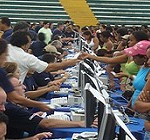The success of the Bolsa Familia, the widely-admired poverty alleviation programme in Brazil, is considered by many as a role model for developing countries. However, not many beyond Latin America know that such programmes are in place in 18 countries of Latin America.
Although Brazil’s Bolsa Familia (or “family allowance”) is the largest such programme in absolute terms, covering 52 million of the country’s 200 million people, Ecuador’s human development voucher (Bono de Desarrollo Humano) has the widest coverage, benefiting 44% of the country’s total population.
According to a report published in March 2013 by the Centre for Distributive, Labour and Social Studies (CEDLAS) of the National University of La Plata, Argentina, these programmes – which reach 19% of the region’s approximately 600 million people – have helped in achieving “a substantial reduction in extreme poverty and a significant fall in inequality.”
The plans differ in format, but they all aim to provide a monthly transfer from state coffers to low-income families or elderly people who work in the informal economy and do not draw pensions. The family plans usually require school attendance and health checks for children under 18.
The CEDLAS report states that the region cannot depend solely on economic growth. Even if there is full employment, social protection is also needed. The study also concludes:
- Cash transfer plans have been useful instruments as part of an overall strategy for reducing poverty and inequality. They are relatively easy to implement, administer, and monitor. The plans have a direct impact on the beneficiaries’ quality of life.
- The conditions attached to the payments are an incentive to change behaviour, promoting better school attendance by children and teenagers, and more regular health checks.
- In the 1990s, the region’s economic growth was associated with greater inequality. In contrast, since the turn of the century, cash transfer programmes have contributed to an acceleration of the reduction of poverty, especially extreme poverty.
- The proportion of people living on less than $2.5 a day fell from 27.8% of the population of Latin America in 1992 to 24.9% in 2003, 16.3% in 2009, and 14.2% in 2010.
- The countries that will need the most aid are those where a high proportion of the population is in the informal economy and therefore lacks health and retirement coverage, such as Bolivia, Ecuador, Mexico, Nicaragua, Paraguay, and Peru.
According to the Economic Commission for Latin America and the Caribbean (ECLAC), the region spent an average of 0.4% of GDP in 2010 on cash transfer programmes. [1]
The CEDLAS report says that the current average expenditure is relatively small compared with other subsidies that benefit the middle and upper classes. While these programmes are sometimes criticised, the CEDLAS report notes that they have a broad social support in most countries and very few candidates to elected posts in the region openly call for a reduction or elimination of such plans.
Ambassador Viswanathan is Distinguished Fellow, Latin America Studies, Gateway House. He is the former Indian Ambassador to Argentina, Uruguay, Paraguay and Venezuela, and Consul General in Sao Paulo.
This blog was exclusively written for Gateway House: Indian Council on Global Relations. You can read more exclusive content here.
For interview requests with the author, or for permission to republish, please contact outreach@gatewayhouse.in.
© Copyright 2013 Gateway House: Indian Council on Global Relations. All rights reserved. Any unauthorized copying or reproduction is strictly prohibited.
References:
1. Cecchini, S and Madariaga, A. (2011). Conditional Cash Transfer Programmes: the recent experience in Latin America and the Caribbean. Retrieved from http://www.eclac.org/cgi-bin/getProd.asp?xml=/publicaciones/xml/6/45096/P45096.xml&base=/mujer/tpl/top-bottom-estadistica.xslt


